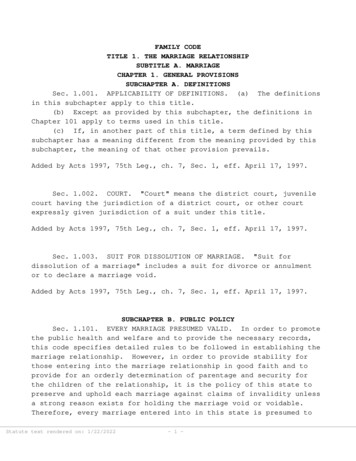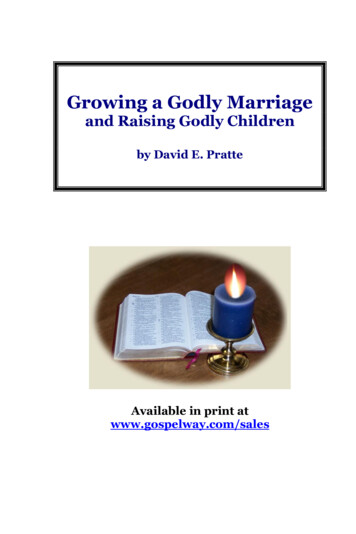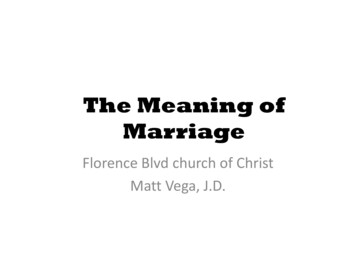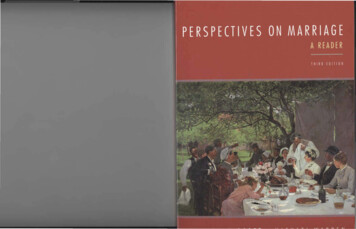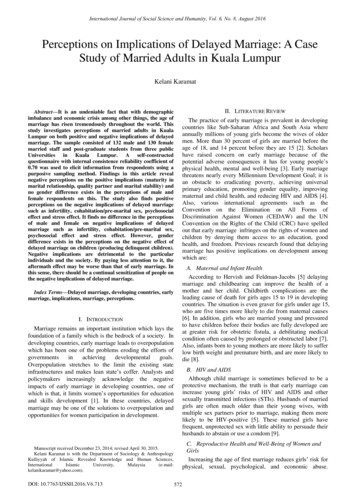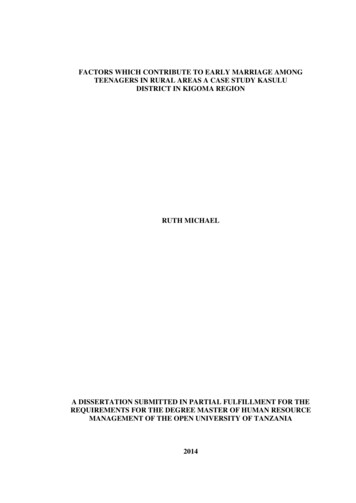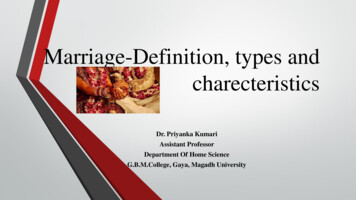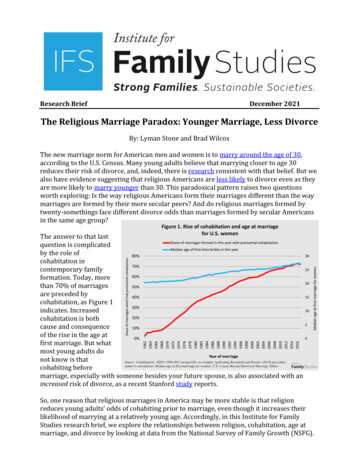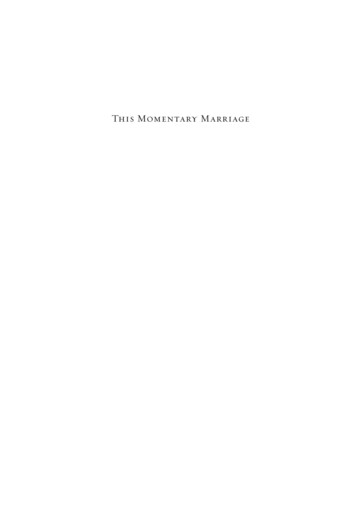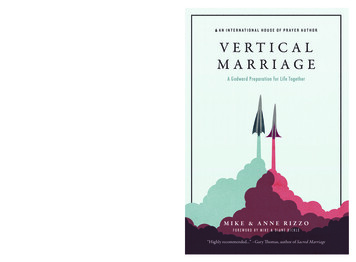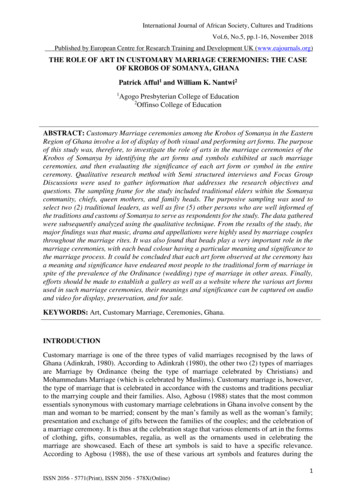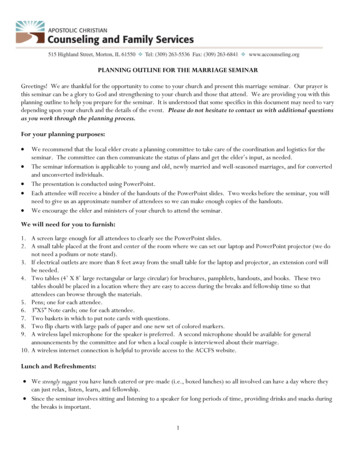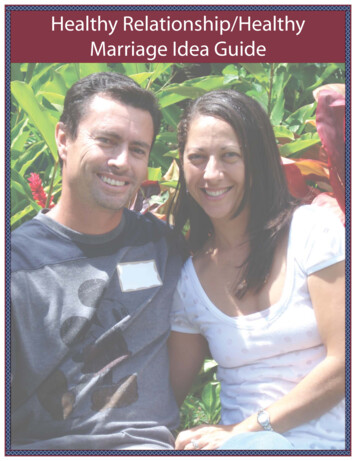
Transcription
Healthy Relationship/HealthyMarriage Idea Guide
HEALTHY rELATIONSHIP/HEALTHYMArrIAGE IdEA GuIdEThere is no typical traditional or cultural way of teaching about becoming a couple, but there are some generalprinciples many native people can identify.For many, the traditional village was a group of inter-related families living together and helping to take care ofeach other. As a young person growing up in this community, there was an understanding that each young person would eventually find a mate outside of his/her family, clan, or village. Whether through arranged marriageor by choice, this served many useful purposes. It widened the gene pool, decreased the possibilities for war byconnecting us as extended family to other communities around us, and increased our opportunities or areas forhunting, fishing, or gathering.While role modeling was one of the primary mechanisms for teaching young people about healthy relationships,there were also many cultural practices in everyday life. For example, among some tribes of the Pacific Northwest, when a man finds a mate, he must spend four seasons in her village learning all he can about her familyhistory, language, social practices, value systems, songs, medicines, spiritual ways, and so forth. At the end ofthose first four seasons, she returns with him to spend four seasons in his village, learning everything she canabout him, his people, and their way of being. At the end of the eight seasons the couple must make a choiceabout which village will be their permanent home. They would then follow the ways of this village, keeping thecultural practices of this community intact. This helped assure a harmonious relationship between the couple.Many tribal cultures passed down numerous teachings, through story, about how a couple should behave andwhy. These stories were typically based on watching animals and helped to illustrate behaviors that might occurin a relationship. Stories of Mink might teach us about appropriate (or inappropriate) sexual behavior. Storiesof Eagle might teach us about staying with our mates. Stories of Wolf could teach us about working together toraise a family. Stories of raven might teach us what happens if we do not heed these teachings.unfortunately, where many tribal people or tribal communities became disconnected from these traditionalteachings, they also became disconnected from the values and principles involved. These principles could provide valuable insight into developing and maintaining healthy and successful relationships today.The two agendas that follow provide examples of a four-hour workshop and a full-day workshop.Page
Healthy Relationship/Healthy Marriage Idea Guide -Hour AgendaTra ner Agenda :00Welcome everyone to the workshop. Open in a culturally appropriate way. Allow for introductionswhere necessary. Begin with an icebreaker/energizer activity to gain focus, build energy andparticipation, and set the tone for the workshop. : Topic: What We’ve LearnedBegin with a large group discussion of the question, “Where and how did we learn about relationships?”Encourage participation from around the room and capture input on a flip chart. Discuss theCharacteristics of Life Experiences (handout) and share real-life experiences. Individually, haveeveryone complete the Trauma Web (activity). As a large group, process some of the thoughts orfeelings that come from the activity. : Break 0:00 Topic: Gender differencesIn a large group, lead a discussion about Hunters and Gatherers (handout) to assure that everyoneunderstands the concept of gender difference affecting behavior. Breaking into small groups, haveeveryone discuss their own experiences of these gender difference impacts. Bring the groups backtogether and have each group share their experiences. 0: 0 Topic: Healthy Conflict Resolution/Healthy CommunicationGuide a large group discussion of What is Conflict? (handout), followed by The Seven Fs of Conflict(handout), and Coyote Language (activity). Moving into different small groups, have each groupidentify at least five other examples of Coyote Language happening around them. Bring the groups backtogether and have everyone share their examples. Finish the topic by sharing Collaborative ConflictResolution (handout). : 0 Topic: Summary and HomeworkCheck for questions or needed group discussion of everything covered today. Have the group discussthe characteristics of a healthy relationship. Have participants complete Three Steps to Changing aHabit (handout). Provide any other tips or information to be shared, including follow-up activities ifyou have any to present. Conclude by having everyone select one thing they can do differently duringthe remainder of the day to begin creating positive and proactive change. :00 ClosingPage
Healthy Relationship/Healthy Marriage Idea Guide -Hour AgendaPart c pant Agenda :00WelcomeIntroductionsIcebreaker : Topic: What We’ve LearnedWhere and how did we learn about relationships?Characteristics of Life Experiences (handout)Trauma Web (activity) : Break 0:00 Topic: Gender differencesHunters and Gatherers (handout) 0: 0 Topic: Healthy Conflict Resolution/Healthy CommunicationWhat is Conflict? (handout)The Seven Fs of Conflict (handout)Coyote Language (activity)Collaborative Conflict Resolution (handout) : 0 Topic: Summary and HomeworkThree Steps to Changing a Habit (handout) :00 ClosingPage 0
Healthy Relationship/Healthy Marriage GuideFull-day AgendaTra ner Agenda :00Welcome everyone to the workshop. Open in a culturally appropriate way. Allow for introductionswhere necessary. Begin with an icebreaker/energizer activity to gain focus, build energy andparticipation, and set the tone for the workshop. : Topic: What We’ve LearnedBegin with a large group discussion of the question, “Where and how did we learn about relationships?”Encourage participation from around the room and capture input on a flip chart. Discuss theCharacteristics of Life Experiences (handout), sharing real-life experiences of the behaviors.Individually, have everyone complete the Trauma Web (activity). As a group, process the thoughts orfeelings that come from the activity. 0: Break :00 Topic: Gender differencesIn a large group, lead a discussion about Hunters and Gatherers (handout) to assure that everyone understands the concept of gender difference affecting behavior. Breaking into small groups, have everyonediscuss their own experiences with these gender difference impacts. Bring the room back together andhave groups check in with each other about these experiences. As a large group, review and discussGiving Effective Feedback (handout). :00 Lunch : 0Topic: Healthy Conflict ResolutionBegin with a discussion about the different causes of conflict with What is Conflict? (handout). Thendiscuss various habits we bring into conflict as The Seven Fs of Conflict (handout). Guide participantsas they individually complete the questionnaire Your Behavior During Conflict (activity). uponcompleting the activity, discuss the results as a group. Complete the topic by sharing CollaborativeConflict Resolution (handout). : 0Topic: Healthy CommunicationOpen the topic with discussion of Coyote Language (activity). Moving into different small groups, haveeach group identify at least five other examples of Coyote Language happening around them. Bring thegroups back together and have everyone share their examples. Individually, have participants completeListening Self-evaluation (activity) and discuss their results with the person next to them. As a largegroup, review the Six Words for Clear Communication (handout). : Break : 0Topic: Being A CoupleTape flip chart pages around the room labeled at the top with the eight topics of the RelationshipRoadmap (activity). divide the group into smaller groups of 4-6 people each. Have each groupPage
brainstorm at each of the lists, discussing the topic and writing their answers for 3-5 minutes beforemoving to the next page. After each group has had a turn at each list, have everyone return to their seatsand as a large group, review and discuss the lists that were created. Encourage participants to do a moredetailed personal version of the exercise at home. Have the group discuss the characteristics of a healthyrelationship. : 0Topic: Life in BalanceHave everyone complete Finding Balance (activity) individually. As a group, discuss where differentpeople placed their different priorities and why. To complete the day have people individually completeThree Steps to Changing a Habit (handout) as homework to take with them. :00ClosingPage
Healthy Relationship/ Healthy Marriage GuideFull-day AgendaPart c pant Agenda :00WelcomeIntroductionsIcebreaker : Topic: What We’ve LearnedWhere and how did we learn about relationships?Characteristics of Life Experiences (handout)Trauma Web (activity) 0: Break :00 Topic: Gender differencesHunters and Gatherers (handout)Giving Effective Feedback (handout) :00 Lunch : 0Topic: Healthy Conflict ResolutionWhat is Conflict? (handout)The Seven Fs of Conflict (handout)Your Behavior During Conflict (activity)Collaborative Conflict Resolution (handout) : 0Topic: Healthy CommunicationCoyote Language (activity)Listening Self-evaluation (activity)Six Words for Clear Communication (handout) :00Break : 0Topic: Being A CoupleRelationship Roadmap (activity) : 0Topic: Life in BalanceFinding Balance (activity)Three Steps to Changing a Habit (handout) :00ClosingPage
those irst four seasons, she returns with him to spend four seasons in his village, learning everything she can about him, his people, and their way of being. At the end of the eight seasons the couple must make a choice about which village will be their permanent home. The
